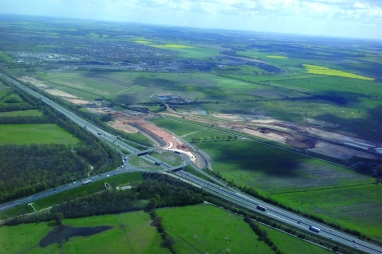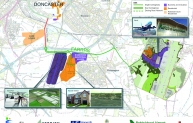Highway to prosperity
Local government can deliver major projects – Doncaster has the evidence. Jackie Whitelaw reports on a new road for the town funded from the Regional Growth Fund.
In the evening, in some parts of Doncaster, you can hear lions roaring. There are three prides at the Yorkshire Wildlife Park close to the town and after only five years in operation the attraction is the second most popular in the county (after York Minster). Nearly half a million people enjoyed the experience last year.
This is relevant because the Park’s success, along with that of Doncaster’s relatively new Robin Hood International Airport close by, are crucial to the economic revival of the whole borough.
And underpinning that revival is a road scheme that will connect visitors, tourists and travellers through the southern part of the borough, with the UK motorway network, opening up sites for redevelopment and job creation along the way.
“If you can create the demand with what you can afford, unlock the development and then move on to the next stage that is often the most practical option.” Doncaster Council Neil Firth.
The Finningley and Rossington Regeneration Route Scheme (FARRRS) links Junction 3 of the M18 to the south of the town with the A638 – the old Great North Road – to the east. Drive a kilometre or so south and you are at the airport, a few more and you reach the wildlife park.
The lions, it has to be said, are late to the party in terms of the reason for this particular transport project. The £56M, 4km long scheme was conceived with idea of making the most of Doncaster’s position at the heart of the country’s motorway and train network and building on the creation of the airport as a catalyst to attract new employers to the area.
“All of our prosperity and vitality was based around industry, particularly coal and rail,” says head of service, transport and major projects for Doncaster Council Neil Firth. “In the 1980s, 90s and the early 2000s the town suffered serious economic decline, high unemployment and deprivation. At one point 11 of our 20 wards were in the bottom 10% of the deprivation indices.
“We had to find ways to dig ourselves out of the economic spiral of decline. So we looked at what we did have going for us. We are in the centre of the country, dissected by the strategic road network in that the A1(M) runs north to south through Doncaster and the M18 east to west. The East Coast Main Line (ECML) means we’re only 88 minutes from London by train. And in 2005 we opened the international airport. That gave us significant opportunities to build on. We are a good place for businesses to base themselves.”
Restrictions on airport growth until access was improved focused attention on a route back to the M18 around Rossington with the added benefit that it would unlock opportunity for development and improve transport options for the village. “Rossington is cut in half by the ECML and at peak times the level crossing can be closed for longer than it is open, waiting for up to six trains to pass each time,” explains Mott MacDonald project manager Nigel Morley.
FARRS funding
Regional Growth Fund £18M
Doncaster MBC £4M
Developer funding £34M
The original plan for FARRRS back in 2008 was that it would be a Department for Transport (DfT) funded scheme but with the recession and the election everything changed. And that is where Doncaster got really clever.
“Everything was put on hold in 2010,” says Firth. “But we didn’t just stop.” There are two major regeneration sites opened up by the project – one is the six million square foot, £400M, inland freight port backed by Verdion (iPort) and the Healthcare of Ontario Pension Plan; the other is the redevelopment of Rossington Colliery including 1,200 new homes. “We were negotiating with developers for funding contributions and that carried on.”
The Council also determinedly acquired funding from the European Development Fund and DfT towards the £32M upgrading of White Rose Way which links central Doncaster to J3 of the M18 via a new bridge over the ECML. This was vital to allow FARRRS to go ahead. The 1.9km dualling scheme, completed in 2013, in particular stopped queues of traffic backing up at the M18 junction, a congestion and safety risk which had put all redevelopment on the south side of Doncaster at risk.
“For FARRRS though, at the end of 2010, we got sight of the Regional Growth Fund,” Firth says. “It was linked to jobs and it required public/private sector joint ventures – we had that. Initially we looked at whether we could augment DfT funding with RGF money but were told we couldn’t. So we took a bold decision and resubmitted the scheme as an RGF project through the Department for Business Innovation & Skills, presenting it as regeneration project with the highway as the means of unlocking development.”
“And it does,” Morley says. “The Council estimates that the potential job creation opportunities with White Rose Way and FARRRS is 20,000, with the inland port creating 5,000 on its own. With the associated developments the scheme unlocks investment of £1.2bn. For the RGF bid we established that in the first five years after completion of the road 1,232 jobs would be created.”
A bright, positive submission, complete with a brochure packed with support from local businesses, and worked up in concert by the Council and Mott MacDonald’s experts in design, engineering, masterplanning and airport development helped get the deal through.
So too did some concerted value engineering to get the original scheme cost of £100M substantially reduced.
The team had a good look at whether the road needed to be dual carriageway all the way to start with, particularly in light of the fact that requirement for and cost of fill was going to be vast as the route needed to be constructed largely on embankment – the M18 junction was elevated, the road then needed to go over the ECML and so on. The Council and Mott MacDonald created a new, very sophisticated transport model to predict future traffic loads and the results allowed them to trim down the scheme while satisfying the developers that the road would have enough capacity.
“Sometimes trying to do it all in one go tips the balance of what is affordable,” Doncaster Council’s Neil Firth.
“The model showed we had to dual the route at the start from the M18 to the inland port but after that we could reduce it to single carriageway,” Morley explains. “That cut the fill from 1.8 million cubic metres (more than enough to fill Wembley stadium) to 800,000 million cubic metres.
“And,” says Firth “we came to an arrangement with the owners of the former colliery site to take the fill from them as part of their developer contribution, cutting purchase and transport costs by £8M.”
On the original plans the FARRRS scheme would have carried on all the way to a new airport access. The decision was also taken to stop the scheme at the A638 and to use the existing highway network to make that connection.
Local support for the road has been high, with few objections to the planning application, while compulsory purchase orders were all negotiated out so no public inquiry was required. Construction of the job by Carillion is now underway with completion of access to iPort expected by October this year and the whole job finishing in January 2016.
Doncaster Council does have an aspiration to continue the FARRRS route all the way to the airport and that extension is now part of the Sheffield City Region Local Enterprise Partnership register of infrastructure projects, with an outline business case using devolved transport funding already in place. “Sometimes trying to do it all in one go tips the balance of what is affordable,” says Doncaster Council’s Neil Firth.
“If you can create the demand with what you can afford, unlock the development and then move on to the next stage that is often the most practical option.”
“We think we are showing here that local authorities can play a successful role in leading delivery of major projects,” Firth says. “We can deliver the funding and can convince the private sector to trust and invest in us.
“But councils have to recognise that they don’t have all the resources they need in house, and they can’t carry them in house. They need to be cognisant of that and augment resources with external consultants to help with the specialisms.
“Delivering major projects for the benefit of local communities isn’t about whether private or public sector is best. It is about the combination of the best of both.”


